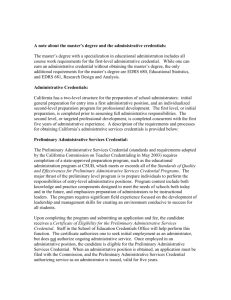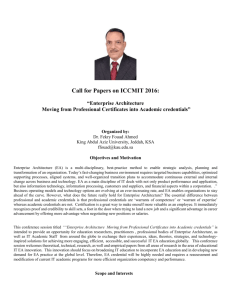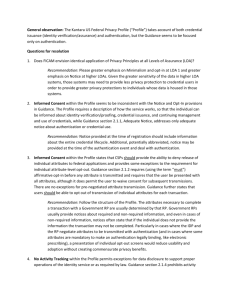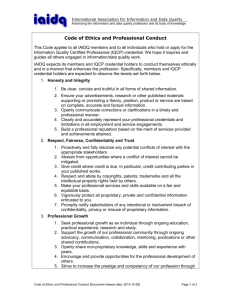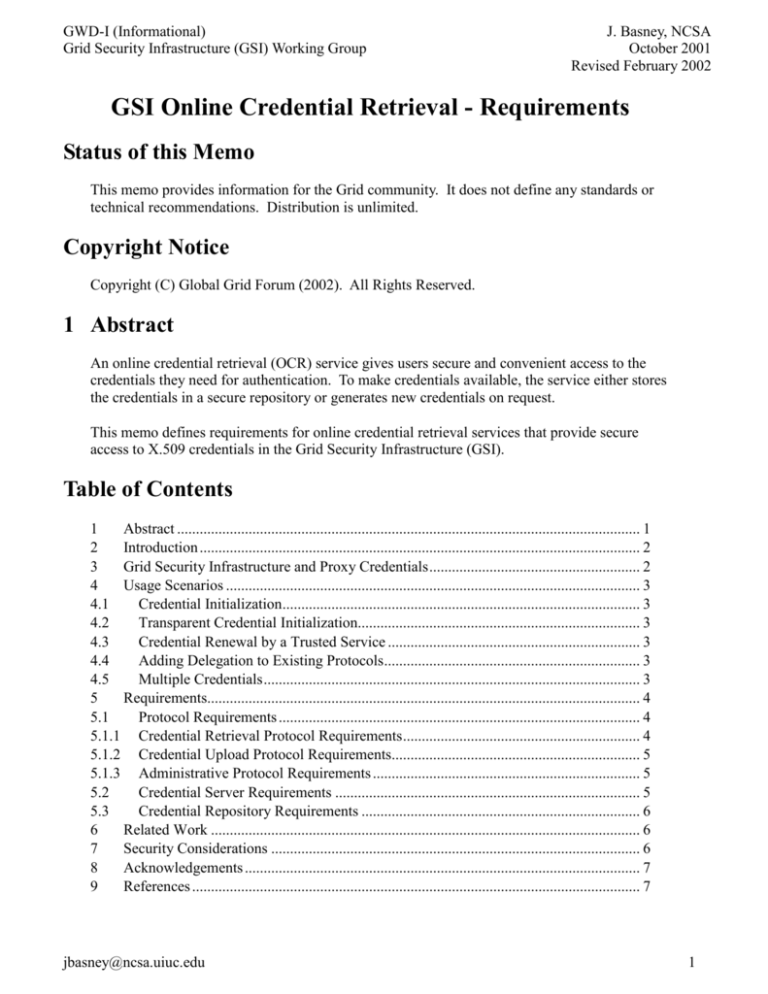
GWD-I (Informational)
Grid Security Infrastructure (GSI) Working Group
J. Basney, NCSA
October 2001
Revised February 2002
GSI Online Credential Retrieval - Requirements
Status of this Memo
This memo provides information for the Grid community. It does not define any standards or
technical recommendations. Distribution is unlimited.
Copyright Notice
Copyright (C) Global Grid Forum (2002). All Rights Reserved.
1 Abstract
An online credential retrieval (OCR) service gives users secure and convenient access to the
credentials they need for authentication. To make credentials available, the service either stores
the credentials in a secure repository or generates new credentials on request.
This memo defines requirements for online credential retrieval services that provide secure
access to X.509 credentials in the Grid Security Infrastructure (GSI).
Table of Contents
1
Abstract ........................................................................................................................... 1
2
Introduction ..................................................................................................................... 2
3
Grid Security Infrastructure and Proxy Credentials ........................................................ 2
4
Usage Scenarios .............................................................................................................. 3
4.1
Credential Initialization............................................................................................... 3
4.2
Transparent Credential Initialization........................................................................... 3
4.3
Credential Renewal by a Trusted Service ................................................................... 3
4.4
Adding Delegation to Existing Protocols .................................................................... 3
4.5
Multiple Credentials .................................................................................................... 3
5
Requirements................................................................................................................... 4
5.1
Protocol Requirements ................................................................................................ 4
5.1.1 Credential Retrieval Protocol Requirements ............................................................... 4
5.1.2 Credential Upload Protocol Requirements.................................................................. 5
5.1.3 Administrative Protocol Requirements ....................................................................... 5
5.2
Credential Server Requirements ................................................................................. 5
5.3
Credential Repository Requirements .......................................................................... 6
6
Related Work .................................................................................................................. 6
7
Security Considerations .................................................................................................. 6
8
Acknowledgements ......................................................................................................... 7
9
References ....................................................................................................................... 7
jbasney@ncsa.uiuc.edu
1
GWD-I (Informational)
10
11
12
February 2002
Author Contact Information ............................................................................................ 8
Full Copyright Notice ..................................................................................................... 8
Intellectual Property Statement ....................................................................................... 9
2 Introduction
Requiring users to manage their credentials has a number of drawbacks. First, users may not be
able or willing to effectively protect their private keys from compromise or loss. Second, users
may access secure services from many devices, and distributing their private keys to each device
can be inconvenient and potentially insecure. Third, users may need multiple credentials to
access different secure services because of differing trust policies, further increasing the user's
key management burden. A service that securely manages user's credentials can therefore
potentially improve both security and usability.
This memo describes usage scenarios and defines requirements for an online credential retrieval
service for the Grid Security Infrastructure (GSI). We invite comments on the scenarios and
requirements in this memo and suggestions for additional scenarios and requirements that should
be considered. Please send comments and suggestions to the GSI working group of the Global
Grid Forum by electronic mail to security-wg@gridforum.org.
The key words "MUST", "MUST NOT", "REQUIRED", "SHALL", "SHALL NOT",
"SHOULD", "SHOULD NOT", "RECOMMENDED", "MAY", and "OPTIONAL" in this
document are to be interpreted as described in RFC-2119 [3].
3 Grid Security Infrastructure and Proxy Credentials
Authentication in the Grid Security Infrastructure (GSI) is based on proxy credentials. A proxy
credential consists of a proxy certificate and an associated private key. The proxy certificate is
an X.509 certificate that is derived from a standard X.509 end entity certificate or another proxy
certificate and signed by the private key associated with the source certificate. Proxy credentials
serve to limit the vulnerability of the end entity private key while supporting GSI requirements
for single sign-on and credential delegation.
Rather than entering a pass phrase to decrypt the private key on every authentication operation,
or stashing the pass phrase or unencrypted key on the local system for repeated use, the user can
use the private key once to create a proxy credential. The proxy certificate contains restrictions,
such as a short lifetime, that limits the vulnerability if the proxy key should be compromised.
The proxy key can then be stashed unencrypted for the duration of the user's session.
Proxy credentials can also be used to delegate credentials to processes acting on the end entity's
behalf without transferring the end entity's private key to the process. Instead, the process
generates its own proxy certificate and key and asks the delegating entity to sign the certificate,
thereby allowing credentials to be forwarded over the network without transferring private keys.
The delegating entity will typically place restrictions in the proxy certificate to limit the
vulnerability of the delegated credential.
jbasney@ncsa.uiuc.edu
2
GWD-I (Informational)
February 2002
4 Usage Scenarios
A GSI online credential retrieval (OCR) service MAY support one or more of the following
usage scenarios.
4.1 Credential Initialization
A user logs in to a computer where his or her credentials are not directly accessible. The user
runs an OCR client program, specifying the location of an OCR service. The program connects
to the OCR service, verifies the identity of the service, and establishes a secure channel to the
service. The user enters a username and pass phrase, which the program sends to the OCR
service to authenticate the user. If the authentication succeeds, the OCR service delegates a
proxy credential to the client program, and the client program stores the proxy credential on the
local system, where the user can use it for subsequent authentication operations.
This description assumes the OCR client program has been previously installed on the system
and the client has the ability to verify the identity of the OCR service (i.e., trusts the Certificate
Authority that issued the OCR service credential).
4.2 Transparent Credential Initialization
This scenario is similar to the previous one, except instead of using a pass phrase, the OCR client
authenticates to the OCR service with the user's local security context, such as a Kerberos ticket.
The user or administrator can modify the login script for the user's local account to run the OCR
client program to transparently retrieve a proxy credential on each login.
4.3 Credential Renewal by a Trusted Service
A user submits a batch job to a trusted scheduler and delegates a credential to the scheduler to be
used by the job. If the credential nears expiration while the job has not yet completed, the
scheduler authenticates to the OCR service with its service credential, proves possession of the
user credential, and retrieves a new credential for the job with an extended lifetime.
4.4 Adding Delegation to Existing Protocols
In this scenario, a user accesses a Grid service using a client program that does not support
credential delegation, for example, using a web browser to access a Grid Portal. The user
connects to the portal, and the portal prompts the user for his or her credential information. The
user enters the username and pass phrase under which the user's credential can be retrieved from
an OCR service. The portal software runs an OCR client program, using the user's username and
pass phrase to obtain credentials for the user, thereby allowing the portal to access Grid resources
on the user's behalf.
4.5 Multiple Credentials
jbasney@ncsa.uiuc.edu
3
GWD-I (Informational)
February 2002
A user has different credentials for authenticating to Grid resources in different administrative
domains. To access a Grid resource, the user's client program queries the resource for the types
of credentials it is willing to accept. The client then queries the OCR service to find a credential
for the user that meets the Grid resource's requirements and retrieves the credential if one is
found.
5 Requirements
This section lists requirements for protocols, servers, and credential repositories that provide
credential retrieval services.
5.1 Protocol Requirements
The online credential retrieval service MUST support a standard protocol for retrieving
credentials. Additional protocols MAY be supported to allow users and administrators to add,
remove, and modify the credentials that may be retrieved from the service. A credential upload
protocol allows authorized clients to insert credentials into a repository for later retrieval or
remove existing credentials from a repository. Administrative protocols allow authorized clients
to modify the authorization requirements for retrieving a credential and other policy restrictions
on the credentials.
Each protocol SHOULD share message formats and authentication mechanisms where possible.
5.1.1 Credential Retrieval Protocol Requirements
The protocol MUST support delegation of X.509 proxy credentials from the server to the client.
Retrieval of other types of credentials, including X.509 end entity credentials, is not considered
at this time and is not required for the usage scenarios described above.
The protocol MUST authenticate the client to the server and MUST allow support of different
client authentication mechanisms. Support for username/passphrase and X.509 authentication is
REQUIRED. Additional authentication mechanisms, such as Kerberos, MAY be supported.
The protocol MUST ensure the integrity of the client's authenticated credential retrieval request
(i.e., using a message integrity check).
If the retrieval protocol requires the client to transfer a secret, such as a pass phrase, to the server,
the protocol MUST authenticate the server to the client before transferring the secret and the
secret MUST be encrypted in transit.
The client MUST verify that the retrieved credentials contain the expected attributes.
The protocol SHOULD support replication of the retrieval service, and the protocol definition
SHOULD include a method for locating a credential retrieval server that can provide the
credentials requested by the client. The credential service may be partially replicated, so a given
credential may be available from some but not all servers. A credential tag and server/domain
name may be required for retrieval requests.
jbasney@ncsa.uiuc.edu
4
GWD-I (Informational)
February 2002
The protocol SHOULD allow the client to choose the attributes of the credential to be retrieved
(according to what the server will allow). For example, the client may be authorized to obtain
credentials signed by different certificate authorities, possibly with different subjects, or the
client may request that the server delegate a credential with specified restrictions. Some
mechanism for querying the set of available credentials would be needed to support this
functionality.
5.1.2 Credential Upload Protocol Requirements
Note: This protocol would apply only to credential retrieval systems that use a credential
repository. The set of credentials available from online certificate authorities, which generate
credentials on demand, would be controlled by an administrative protocol rather than an upload
protocol.
The protocol MUST support delegation of X.509 proxy credentials from the client to the server.
The protocol MUST allow authenticated clients to remove previously delegated credentials from
the repository.
The protocol MUST allow the client to associate one or more authentication requirements with
an uploaded credential. The client can choose the username/passphrase pair(s) or X.509
identities that are authorized to retrieve the credential.
The protocol MUST allow the client to specify lifetime restrictions for retrieved credentials that
are shorter than the lifetime of the uploaded credential. This allows the client to upload a longlived credential to the repository while minimizing the vulnerability of credentials retrieved from
the repository.
The protocol MUST authenticate the server to the client to prevent uploading credentials to an
untrusted server.
The protocol SHOULD authenticate the client to the server and verify that the client is
authorized to upload credentials. Client authentication may not be needed for "public utility"
servers willing to store credentials for any Grid users.
The protocol MAY allow the client to associate additional restrictions with the credential to be
enforced by the server beyond any policy restrictions encoded in the credential itself.
5.1.3 Administrative Protocol Requirements
The protocol SHOULD allow authorized clients to associate new authentication requirements for
retrieval of credentials. For example, clients can associate a new username/passphrase with a
credential.
5.2 Credential Server Requirements
jbasney@ncsa.uiuc.edu
5
GWD-I (Informational)
February 2002
The server MUST restrict authenticated clients to retrieve only those credentials for which they
are authorized. The server SHOULD allow multiple (identity, authentication mechanism) pairs
to be authorized to retrieve credentials, on a per-credential basis.
The server MUST enforce limits on the maximum lifetime of delegated credentials, both on a
per-credential basis and for all credentials managed by the server.
The server SHOULD securely log all protocol transactions for auditing purposes.
The server MAY support online notification of protocol transactions to authorized parties,
including notification of requests that must be authorized before they proceed.
5.3 Credential Repository Requirements
Private keys stored in the repository SHOULD be encrypted and the information required to
decrypt the keys SHOULD NOT be stored in the repository. In this case, the client must include
the information required to decrypt the key in the credential retrieval request, so the server can
decrypt the key and use it to perform delegation. However, the server should discard the
decrypted key and the information used to decrypt it immediately after performing the
delegation. This may not be possible for all authentication mechanisms. For passphrase-based
authentication, the private keys can be encrypted with the pass phrase.
The credential repository SHOULD be replicable.
6 Related Work
Protocols for secure credential retrieval are under development in the IETF Securely Available
Credentials (SACRED) working group. The working group has produced a requirements
document [2] and draft framework and protocol documents. Many of the SACRED requirements
are equivalent to requirements listed in this memo. However, the SACRED requirements state
that the credential format MUST be opaque to the protocol and the protocol MUST NOT force
credentials to be present in cleartext at the server. These requirements disallow X.509 proxy
delegation as specified in this memo. The author(s) of this memo will work with the SACRED
working group to address this issue. The development of standards for online credential retrieval
in GSI SHOULD include input from the SACRED working group and SHOULD be compatible
when possible with SACRED requirements and standards.
The IETF Public-Key Infrastructure (X.509) (PKIX) online credential management protocols [1]
define standards for interacting with online Certificate Authorities and certificate repositories.
Any OCR protocols developed for GSI should be designed to be compatible with the PKIX
protocols and framework.
7 Security Considerations
Centralized credential management raises significant security concerns. The central server is an
attractive target for attack because of the large number of credentials that may be compromised.
jbasney@ncsa.uiuc.edu
6
GWD-I (Informational)
February 2002
The compromise of a certificate repository could potentially compromise all credentials stored
there. Encrypting the credentials as recommended above can limit the vulnerability by requiring
an additional offline attack to decrypt the credentials. However, a compromised server could
instead wait for clients to retrieve their credentials to learn the encryption keys.
The compromise of a server that generates credentials on demand by signing them with a
certificate authority key (i.e., an online certificate authority) would allow an attacker to generate
and use credentials for any principal in the security domain until the certificate authority key is
revoked.
It is important to place these risks in context. Kerberos Key Distribution Centers implement a
form of centralized credential management, so community experience with Kerberos security can
suggest best practices for securing other types of centralized credential servers. A professionally
administered, dedicated credential server should provide a higher level of security than current
practice, where end users store their private keys on less secure end systems, including network
file systems where eavesdropping on unencrypted traffic is possible.
A credential retrieval service deployed by an organization must be acceptable under the relevant
certificate authority policy documents [4]. The management practices for deployed credential
retrieval systems should be documented and audited.
Keys used by the credential retrieval service and credentials retrieved from the service are not
suitable for generating non-reputable digital signatures because the credential retrieval service
has access to the keys. However, the suitability of end entity credentials for generating nonreputable signatures is not affected by delegating proxy credentials to a credential retrieval
service. The credential retrieval service is not intended to manage keys for digital signatures and
is not a key escrow system.
Credential renewal bypasses the lifetime restriction in the proxy credential and therefore must be
implemented with care. An attacker could potentially use a poorly designed OCR service to
renew a compromised proxy credential indefinitely. Several techniques can reduce this
vulnerability. Allowing only trusted services to renew credentials requires that the attacker also
compromise the trusted service's credential. The OCR service can limit the total renewable
lifetime of a given credential (as is done with Kerberos renewable tickets). Finally, once a
compromise is detected, the OCR service can be configured to stop renewing any compromised
credentials. The OCR service's audit logs should provide information about each renewal
attempt.
8 Acknowledgements
Discussions with Randy Butler, Laura Pearlman, Steve Tuecke, and Von Welch led to the initial
version of this memo.
9 References
jbasney@ncsa.uiuc.edu
7
GWD-I (Informational)
February 2002
[1]
Adams, C. and S. Ferrell, "Internet X.509 Public Key Infrastructure Certificate
Management Protocols," RFC 2510, March 1999.
[2]
Arsenault, A. and S. Ferrell, "Securely Available Credentials - Requirements," RFC 3157
(Informational), August 2001.
[3]
Bradner, S., "Key words for use in RFCs to Indicate Requirement Levels," BCP 14, RFC
2119, March 1997.
[4]
Chokhani, S. and W. Ford, "Internet X.509 Public Key Infrastructure Certificate Policy
and Certification Practices Framework," RFC 2527 (Informational), March 1999.
10 Author Contact Information
Jim Basney
National Center for Supercomputing Applications
University of Illinois at Urbana-Champaign
605 E. Springfield Ave.
Champaign, IL 61820-5518
Phone: 217-244-1954
Email: jbasney@ncsa.uiuc.edu
11 Full Copyright Notice
Copyright (C) Global Grid Forum (2002). All Rights Reserved.
This document and translations of it may be copied and furnished to others, and derivative works
that comment on or otherwise explain it or assist in its implementation may be prepared, copied,
published and distributed, in whole or in part, without restriction of any kind, provided that the
above copyright notice and this paragraph are included on all such copies and derivative works.
However, this document itself may not be modified in any way, such as by removing the
copyright notice or references to the GGF or other organizations, except as needed for the
purpose of developing Grid Recommendations in which case the procedures for copyrights
defined in the GGF Document process must be followed, or as required to translate it into
languages other than English.
The limited permissions granted above are perpetual and will not be revoked by the GGF or its
successors or assigns.
This document and the information contained herein is provided on an "AS IS" basis and THE
GLOBAL GRID FORUM DISCLAIMS ALL WARRANTIES, EXPRESS OR IMPLIED,
INCLUDING BUT NOT LIMITED TO ANY WARRANTY THAT THE USE OF THE
INFORMATION HEREIN WILL NOT INFRINGE ANY RIGHTS OR ANY IMPLIED
WARRANTIES OF MERCHANTABILITY OR FITNESS FOR A PARTICULAR PURPOSE.
jbasney@ncsa.uiuc.edu
8
GWD-I (Informational)
February 2002
12 Intellectual Property Statement
The GGF takes no position regarding the validity or scope of any intellectual property or other
rights that might be claimed to pertain to the implementation or use of the technology described
in this document or the extent to which any license under such rights might or might not be
available; neither does it represent that it has made any effort to identify any such rights. Copies
of claims of rights made available for publication and any assurances of licenses to be made
available, or the result of an attempt made to obtain a general license or permission for the use of
such proprietary rights by implementers or users of this specification can be obtained from the
GGF Secretariat. The GGF invites any interested party to bring to its attention any copyrights,
patents or patent applications,
or other proprietary rights which may cover technology that may be required to practice this
recommendation. Please address the information to the GGF Executive Director.
jbasney@ncsa.uiuc.edu
9


